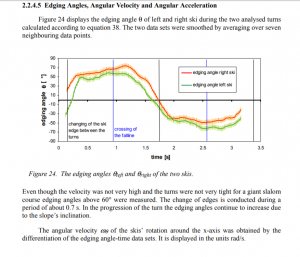Hi
@karlo,
Nice to have you in this thread. I am glad you have mentioned this technology, as I have worked with it for more than six years, wrote my PhD based on it and thanks to it I joined the Snowcookie team You can see in this
paper that we have tested our system extensively in one of the best human motion laboratories in the Europe in collaboration with a great researchers team. Unfortunately,
Vicon is hard to apply outside lab, on the slopes – it uses passive markers and light reflections, which in snow conditions behave really bad. Moreover, setting up such a system on the slope is extremely difficult, as this hardware (cameras, processing unit, network devices) is very fragile and must be precisely setup.
You also mentioned a bodysuit that you could wear. You won`t believe it, but I have also work on that technology designing and developing firmware and algorithmic part for it (
quaternions algebra for analyzing, compressing and de-noising rotations in joints with
lifting scheme - my PhD topic). You can check the results
here. This technology is still in development stage as it is a research project, but some commercial solutions are already available if you are interested in, i.e.
Rokoko. Costumes are much easier to use on the slopes, but this technology has its weaknesses too. This is a cloth with IMU sensors within it (accelerometer, gyroscope and magnetometer). As all clothes it is moving around our body and we have no control on it. Considering skiers dynamics you can imagine what can happen - recorded data can be useless or hard to interpret. With proper data analysis we can fix it to some point but still – costume might be uncomfortable for skiers and is prone to various damages (usually broken cables, if any, holes in pockets for sensors, other communication issues and so one). There are also problems with cleaning those clothes, with batteries, calibration and many more. If you are interested in details I will be happy to answer all your questions about it.
As for our system – we are currently working with data collected close to sensor attached places – skis and chest. What you were mentioning (hip dumping, stable pelvis) are parts of kinematic chain that we cannot observe directly. We are working on dedicated motion models that learn to estimate what is happening in between chest and skies based on recorded forces, angular velocities and orientations as a function of skiers speed. As this is very complex task, it might appear as soon as winter season 2021. On the other hand, placing sensors on hips/pelvis will allow easily to analyze mentioned behavior based on vibrations (accelerations). If you go through this
paper you will notice, that at those places we have mainly frequencies in range 4-10 Hz, where our sensors can work easily with 100Hz sampling, allowing to analyze signals from 50Hz up, according to
Nyquist–Shannon sampling theorem. But skip this signal processing theory – what I wanted to say is that either we build dedicated motion models analyzing mentioned behavior indirectly, based on what we have right now, or we could scale up our system in the future with additional sensors (within a belt?) to observe those places directly. In the end – this is not something we could not do, just a matter of time, founds and user requirements that have to convert in the end into a revenue.
And the feedback - if you have all the data, it is just a matter of your imagination how would you like to get it

Cheers
Mati

